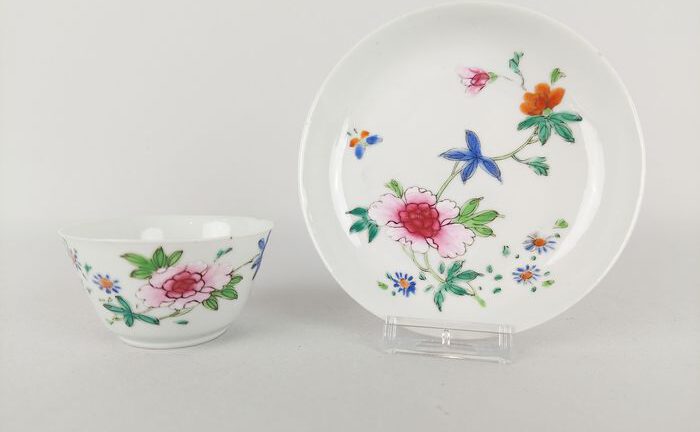Famille rose (French for “pink family”) is a type of Chinese porcelain introduced in the 18th century and defined by the presence of pink colour overglaze enamel. It is a Western classification for Qing dynasty porcelain known in Chinese by various terms: fencai, ruancai, yangcai, and falangcai. The colour palette was introduced in China during the reign of Kangxi (1654–1722) by Western Jesuits who worked at the palace, but perfected only in the Yongzheng era when the finest pieces were made.

Although famille rose is named after its pink coloured enamel, the colour may actually range from pale pink to deep ruby. Apart from pink, a range of other soft colour palettes are also used in famille rose. The gradation of colours was produced by mixing coloured enamels with ‘glassy white’ (玻璃白, boli bai), an opaque white enamel (lead arsenate), and its range of colour was further extended by mixing different colours.
Famille rose was popular in the 18th and 19th century, and it continued to be made in the 20th century. Large quantity of famille rose porcelain were exported to Europe, United States and other countries, and many of these export wares were Jingdezhen porcelain decorated in Canton. Porcelains with famile rose palette were also produced in European factories.
Origin
The origin of famille rose is not entirely clear. The pink colour palette was achieved in Europe through the use of purple of Cassius made of colloidal gold and first used on glass. It is generally believed that the use of this new colour palette in China was introduced by Jesuits in China to the Imperial court, initially on enamels used on metal wares such as cloisonné produced in the falang or enamel workshop (珐琅作), or through adaptation of enamels used in tin-glazed South German earthenware. The term used by Tang Ying (who oversaw the production of porcelain at Jingdezhen) and in Qing documents was yangcai (“foreign colours”), indicating its foreign origin or influence.Research, however, has failed to show that the chemical composition of the pink enamel pigment to be the same as that of the European one, although the cobalt blue of the enamel from some famille rose pieces has been determined to be from Europe. The oil used in gold-red Chinese enamel was doermendina oil instead of turpentine oil used in the West. Colloidal gold may have been previously available for use in Jingdezhen to achieve such colours, and gold-red enamel technique from Guangdong was used during the reign of Kangxi. Rudimentary famille rose have been found in Chinese porcelain from the 1720s, although the technique was not fully developed until around 1730 during the Yongzheng period. The pink of the early pieces of the 1720s were darker in colours made with ruby-coloured glass, but after 1725 softer shades were achieved by mixing with white enamels.
At the Palace workshops in Beijing, experimentations was conducted under the supervision of Prince Yi to develop a range of enamel colours and techniques for applying the such enamels onto blank porcelain supplied by Jingdezhen. These blank porcelain would not have been produced at the Palace due to the polluting nature of the big kilns, and pieces of porcelain decorated at the palace and then fired in muffle kilns are called falangcai. Court painters were employed to make drafts that may include calligraphy and poetry to decorate such wares, which produced a new aesthetic style of decoration on porcelain distinct from those used outside the court.Falangcai decorations may be painted on a white ground, or on a coloured ground with yellow the most popular. As falangcai was produced at the palace for its exclusive use, there are relatively fewer pieces of falangcai porcelain.


